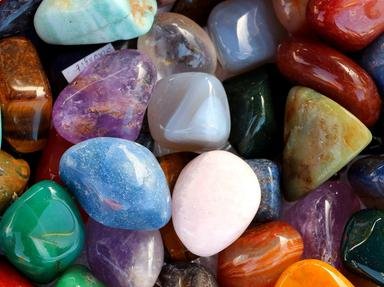Quiz Answer Key and Fun Facts
1. The sapphire is a member of the corundum family of minerals. All corundum gems are known as sapphires except for those of what colour?
2. Until the end of the 20th century, non-blue sapphires were not called sapphires at all but were given names that reflected other gems of the same colour. What prefix was given to these gems to indicate that they were coloured corundum?
3. Given the confusion over what constituted a sapphire it was perhaps understandable that some people were unaware of what treasures they had. In 1938 in Australia, the "Black Star of Queensland" was discovered, from which the largest black star sapphire in existence was cut. In 1947 it was sold to Los Angeles jeweller Harry Kazanjian. During the 10 years from its discovery until its sale, which purpose did the stone fulfil?
4. Sapphire is mentioned in several places in the bible and some traditions suggest that Moses received the ten commandments carved into sapphire. However, modern scholars suggest that the best translation of the Hebrew "sapir", as mentioned in these texts, is which other blue mineral?
5. The sapphire has been viewed as a stone of great significance from ancient times. The Persians gave it a particularly central role in nature. What natural phenomenon did they believe that the sapphire was responsible for?
6. The earliest, clearly definable written record of sapphire as the gem we know it as today can be found in the Far Eastern travelogue of which 13th century explorer?
7. Gifted to the American Museum of Natural History by banker J.P. Morgan in 1900, this 563-carat star sapphire was stolen from the museum in 1964, along with several other gems including the Eagle Diamond, when a cat burglar discovered that the battery powering its alarm system had been allowed to go flat. What was the name of the gem?
8. The Stuart Sapphire was smuggled out of England when the future James II went into exile in France following the English Civil War. On his death he passed the gemstone on to his son, "The Old Pretender" James Stuart, who in turn left it to his son Cardinal Henry Stuart. Two centuries later, in 1937, it found a new home. Where?
9. The city of Pailin takes its name from the otters who, legend attests, carried in their mouths marvellous blue sapphires. By association, in the local Khmer language, the word Pailin became the word for the stones themselves. In which country would you find Pailin?
10. According to ancient legend, the first being to wear a sapphire was a rival of Zeus, who stole the jewel at the same time as he stole fire to give to humankind. Who was this Titan who was punished for the theft by being chained to a rock and having his liver pecked away?
Source: Author
Snowman
This quiz was reviewed by FunTrivia editor
gtho4 before going online.
Any errors found in FunTrivia content are routinely corrected through our feedback system.
